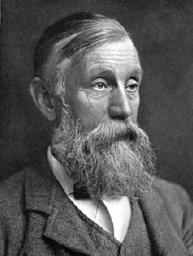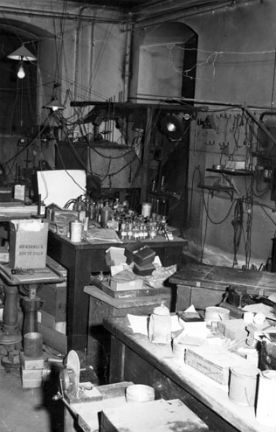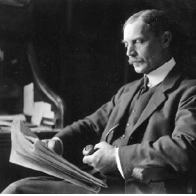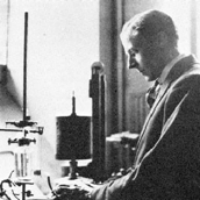
The legacy of Sir Michael Foster
The story of the earliest days of the Laboratory is in effect the story of a single man, Michael Foster. Physiology was taught here essentially as a branch of Anatomy until the appointment of Foster not by the University but by Trinity College (as Praelector in Physiology), apparently acting in response to suggestions by Huxley, G. H. Lewes and his wife, the author George Eliot. The University at first simply supplied a room, furnished with basic equipment by Trinity, though in 1878 a purpose-built laboratory was constructed on the east side of Downing Street near the recently-opened Cavendish Laboratories. In a preface to his Studies from the Physiological Laboratory in the University of Cambridge Foster expressed his gratitude for being permitted to occupy ‘at some inconvenience to others, the two University rooms in which my lectures are given, the practical teaching of my class conducted and the physiological work carried on. I have presumed on their kindness and ventured to call these rooms the Physiological Laboratory of the University of Cambridge’.
Though Foster’s contributions to research were not enduring, the hallmark of his teaching was a passionate commitment to the principle that learning should be firmly based on observation and experiment, and the closest integration between lectures and practicals. In Foster’s Royal Society obituary, W. H. Gaskell wrote that Foster "insisted that practical work, carried on by the student himself, illustrative of the facts on which the lecture was based, must  immediately follow the lecture. (In this he was following principles used by Huxley). The physiology of each organ must be dealt with as a whole in the lecture, and the practical work must be so arranged as to bring home to the student all of the points of each lecture at the time ... His ideal laboratory would be of sufficient size to provide each student with his own working place, both in the histological and in the chemical department at the same time. He also - and this was one of the great reasons of his success - encouraged his students at the very earliest moment to engage in some original research, and then persuaded them to give a few lectures of an advanced character upon the subject on which they were working: for, as he said, there is no way of discovering gaps in your knowledge of a subject better than lecturing on it." From these principles can be traced not only the present Part II, with its research projects that frequently result in published papers, but also the Foster Club at which members of the laboratory talk relatively informally about what they are doing. (Another legacy is the lab cricket team: Foster was also an avid cricketer, and organised annual matches between the staff and students, or the staff and assistants, in which he would himself be captain.)
immediately follow the lecture. (In this he was following principles used by Huxley). The physiology of each organ must be dealt with as a whole in the lecture, and the practical work must be so arranged as to bring home to the student all of the points of each lecture at the time ... His ideal laboratory would be of sufficient size to provide each student with his own working place, both in the histological and in the chemical department at the same time. He also - and this was one of the great reasons of his success - encouraged his students at the very earliest moment to engage in some original research, and then persuaded them to give a few lectures of an advanced character upon the subject on which they were working: for, as he said, there is no way of discovering gaps in your knowledge of a subject better than lecturing on it." From these principles can be traced not only the present Part II, with its research projects that frequently result in published papers, but also the Foster Club at which members of the laboratory talk relatively informally about what they are doing. (Another legacy is the lab cricket team: Foster was also an avid cricketer, and organised annual matches between the staff and students, or the staff and assistants, in which he would himself be captain.)
In 1883 Foster’s work was recognised by the foundation of the first Professorship of Physiology in the University; by then he was heavily occupied with the editorship of the Journal of Physiology, founded in 1878, with successive editions of his influential Text-book of Physiology, and his secretaryship of the Royal Society; he had also been one of the prime movers in creating the Physiological Society itself. J. N. Langley wrote of him: "Sir Michael Foster’s varied work in life was only made possible by his sincere and genuine nature. He was a man of large aims, and generous enthusiasms, of strong initiative and unusual powers of inducing others to see as he did."
Langley and Adrian
 At his death, in 1907, Foster left behind him a team of enthusiasts, of whom perhaps John Newport Langley was to be the most influential. Langley was not a natural lecturer: Dale wrote that he "had no gift of inspiration as a lecturer , but I got more from Langley than I recognised at the time", while Joseph Barcroft recalled that his lectures were mines of information but difficult to follow, but that as a Demonstrator it was a matter of conscience to Langley to demonstrate through each class period and to get to know each man individually: it was then that his greatness was conveyed to the student. As well as being an energetic editor of the Journal, and nearly single-handedly establishing the physiology of the autonomic nervous system, as Professor (1903) he presided over the Laboratory’s move in 1914 to the handsome building provided by the generosity of the Drapers Company.
At his death, in 1907, Foster left behind him a team of enthusiasts, of whom perhaps John Newport Langley was to be the most influential. Langley was not a natural lecturer: Dale wrote that he "had no gift of inspiration as a lecturer , but I got more from Langley than I recognised at the time", while Joseph Barcroft recalled that his lectures were mines of information but difficult to follow, but that as a Demonstrator it was a matter of conscience to Langley to demonstrate through each class period and to get to know each man individually: it was then that his greatness was conveyed to the student. As well as being an energetic editor of the Journal, and nearly single-handedly establishing the physiology of the autonomic nervous system, as Professor (1903) he presided over the Laboratory’s move in 1914 to the handsome building provided by the generosity of the Drapers Company.

One of the lecturers at that date was Edgar Adrian, later Baron Adrian of Cambridge, O.M., F.R.S. and Nobel Laureate, President of the Royal Society and Master of Trinity College. His basement room, inherited from Keith Lucas, the brilliant experimentalist so tragically killed in a flying accident during the war, was specially shielded from vibrations that might disturb the string galvanometers and capillary electrometers used for electrical recording. It contained, in Carl Pfaffman’s words the most glorious clutter ever seen’ (as can be verified in the photograph on the left, taken by Peter Starling in 1964 - with some items that had lain untouched for 40 years).
It was here, during ‘one day’s experiment that Adrian suddenly realised while recording using his new amplifier from a frog nerve-muscle preparation that what seemed to be a tiresomely oscillating electrical artefact only occurred when the muscle was hanging unsupported: "The explanation suddenly dawned on me ... a muscle hanging under its own weight ought, if you come to think of it, to be sending sensory impulses up the nerves coming from the muscle spindles ... That particular day’s work, I think, had all the elements that one could wish for. The new apparatus seemed to be misbehaving very badly indeed, and I suddenly found it was behaving so well that it was opening up an entire new range of data ... it didn’t involve any particular hard work, or any particular intelligence on my part. It was just one of those things which sometimes happens in a laboratory if you stick apparatus together and see what results you get.
Written by by Prof. R. H. S. Carpenter.
References
W. J. O’Connor (1988) Founders of British Physiology: A biographical dictionary, 1820-1885, Manchester University Press
E. D. Adrian (1954) Memorable experiences in research, Diabetes 3 17-18
Joseph Barcroft (1925) Nature 116 872-3
J. K. Bradley, E. M. Tansey (1996) The coming of the electronic age to the Cambridge Physiological Laboratory: E. D. Adrian's valve amplifier in 1921, Notes and Records of the Royal Society 50 217-228
W. H. Gaskell (1908) Proc. Roy. Soc. B 80 lxx-lxxxi
A. L. Hodgkin (1992) Chance and Design: Reminiscences of Science in Peace and War, Cambridge University Press
A. L. Hodgkin (1977) Chance and design in electrophysiology: an informal account of certain experiments on nerve carried out between 1934 and 1952, In The Pursuit of Nature, A. L Hodgkin (Ed), Cambridge University Press
J. N. Langley (1925) University of Cambridge: Department of Physiology. Methods and Problems of Medical Education, Third Series, The Rockefeller Foundation, New York, pp. 7-17
G. M. Shepherd and Janice Brown (1989) The peak of electrochemical experiments in physiology: a unique view through Walter Miles’ "Report of a Visit to Foreign Laboratories" in 1920, Caduceus 5 1-84

